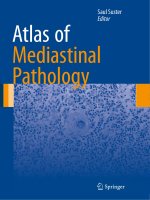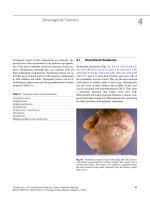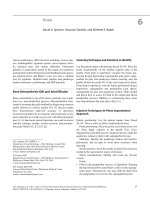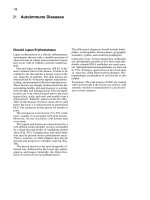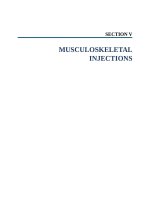Ebook Atlas of polysomnography (2/E): Part 2
Bạn đang xem bản rút gọn của tài liệu. Xem và tải ngay bản đầy đủ của tài liệu tại đây (21.48 MB, 133 trang )
CHAPTER
5
Limb Movement Disorders
James D. Geyer, MD
Troy A. Payne, MD
Paul R. Carney, MD
197
Chap05.indd 197
8/6/2009 4:13:49 PM
198
CHAPTER 5
FIGURE 5-1 Polysomnogram: Standard montage; 60-second page.
Clinical: 58-year-old woman with a low back injury and frequent nocturnal leg movements.
Staging: Stage N1 sleep.
EMG: Unilateral (left) periodic leg movements.
Chap05.indd 198
8/6/2009 4:13:50 PM
LIMB MOVEMENT DISORDERS
199
FIGURE 5-2 Polysomnogram: Standard montage; 120-second page.
Clinical: 40-year-old woman with restless legs syndrome and a right lumbar radiculopathy.
Staging: Stage N3 sleep.
EMG: Unilateral (right) periodic leg movements.
Chap05.indd 199
8/6/2009 4:13:52 PM
200
CHAPTER 5
FIGURE 5-3 Polysomnogram: Standard montage; 120-second page.
Clinical: 62-year-old man with excessive daytime sleepiness and a history of kicking his wife at night.
Staging: Stage N2 sleep with K complexes. The K complexes accompany some but not all of the periodic
limb movements.
Respiratory: Snoring with otherwise normal respirations.
EMG: Bilateral periodic leg movements starting slightly earlier on the left side.
Chap05.indd 200
8/6/2009 4:13:53 PM
LIMB MOVEMENT DISORDERS
201
FIGURE 5-4 Polysomnogram: CPAP and PLM montage; 30-second page.
Clinical: 68-year-old man with obstructive sleep apnea and peripheral neuropathy.
Staging: Stage N2 sleep.
Respiratory: Normal respirations.
EMG: Right periodic leg movements and fragmentary myoclonus in both right and left leg channels.
Chap05.indd 201
8/6/2009 4:13:55 PM
202
CHAPTER 5
FIGURE 5-5 Polysomnogram: Standard montage; 30-second page.
Clinical: 64-year-old man with excessive daytime sleepiness and frequent nocturnal leg movements.
Staging: Stage N2 sleep.
Respiratory: Effort increases with the arousal.
EMG: Bilateral periodic leg movements with an associated arousal.
Chap05.indd 202
8/6/2009 4:13:57 PM
LIMB MOVEMENT DISORDERS
203
FIGURE 5-6 Polysomnogram: CPAP montage; 120-second page.
Clinical: 39-year-old man with obstructive sleep apnea.
Staging: Stage N2 sleep.
Respiratory: Normal respirations while using CPAP.
EMG: Asymmetric periodic leg movements. The compressed time base facilitates identification of the
periodicity of the movements.
Chap05.indd 203
8/6/2009 4:13:59 PM
204
CHAPTER 5
FIGURE 5-7 Polysomnogram: Expanded EEG montage; 60-second page.
Clinical: 44-year-old woman with excessive daytime sleepiness and low back pain.
Staging: Stage N2 sleep.
Respiratory: Normal respirations.
EMG: Periodic leg movements with associated tachycardia. The compressed time base facilitates identification
of the periodicity of the movements.
EKG: A transient increase in the heart rate accompanies the periodic leg movements, despite no definite EEG
evidence of an arousal.
Chap05.indd 204
8/6/2009 4:14:01 PM
LIMB MOVEMENT DISORDERS
205
FIGURE 5-8 Polysomnogram: Expanded EEG montage; 30-second page.
Clinical: 44-year-old woman with excessive daytime sleepiness and low back pain.
Staging: Stage N2 sleep.
Respiratory: Normal respirations.
EMG: Periodic leg movements associated with tachycardia.
EKG: A transient increase in the heart rate accompanies the periodic leg movements, despite no definite
EEG evidence of an arousal.
Chap05.indd 205
8/6/2009 4:14:03 PM
206
CHAPTER 5
FIGURE 5-9 Polysomnogram: Expanded EEG montage; 30-second page.
Clinical: 58-year-old man with excessive daytime sleepiness.
Staging: Stage N2 sleep.
Respiratory: Normal respirations.
EMG: Periodic leg movements with arousals and tachycardia.
EKG: A transient increase in the heart rate occurs with the arousal and periodic leg movement.
Chap05.indd 206
8/6/2009 4:14:05 PM
LIMB MOVEMENT DISORDERS
207
FIGURE 5-10 Polysomnogram: Standard montage; 30-second page.
Clinical: 32-year-old woman with restless legs syndrome.
Staging: Stage wake.
Respiratory: Normal respirations.
EMG: Frequent leg movements during wakefulness are typical of restless legs syndrome.
Chap05.indd 207
8/6/2009 4:14:08 PM
Chap05.indd 208
8/6/2009 4:14:10 PM
CHAPTER
6
Parasomnias
James D. Geyer, MD
Troy A. Payne, MD
Paul R. Carney, MD
209
Chap06.indd 209
8/6/2009 4:15:14 PM
210
CHAPTER 6
FIGURE 6-1 Polysomnogram: Expanded EEG montage; 30-second page.
Clinical: 41-year-old man with witnessed apneas and tooth grinding.
Staging: Stage N1 sleep.
Respiratory: Normal respirations.
Behavior: Bruxism. Bursts of EMG activity occur at a rate of about 1/second in the EEG, chin EMG, and
EOG channels.
Chap06.indd 210
8/6/2009 4:15:14 PM
PARASOMNIAS
211
FIGURE 6-2 Polysomnogram: Standard montage; 60-second page.
Clinical: 26-year-old woman with excessive daytime sleepiness, tooth grinding, and morning headache.
Staging: Probable stage N1 sleep but difficult to stage because of artifact.
Respiratory: Normal respirations.
Behavior: Bruxism. Rhythmic bursts of EMG activity occur about every 4 seconds.
Chap06.indd 211
8/6/2009 4:15:16 PM
212
CHAPTER 6
*
FIGURE 6-3 Polysomnogram: Standard montage; 30-second page.
Clinical: 47-year-old woman with excessive daytime sleepiness.
Staging: Stage N1 sleep.
Respiratory: Normal respirations.
Behavior: Movements of the left leg (*) occur rhythmically at a rate of about 1/second, characteristic of
rhythmic movement disorder. Movement artifact is evident in the thoracic and abdominal channels.
Chap06.indd 212
8/6/2009 4:15:18 PM
PARASOMNIAS
*
*
*
213
*
FIGURE 6-4 Polysomnogram: Standard montage; 120-second page.
Clinical: 47-year-old woman with excessive daytime sleepiness.
Staging: Stage wake.
Respiratory: Normal respirations.
Behavior: Movements of the left leg (*) occur rhythmically at a rate of about 1/second, with a brief
period of quiescence between the runs of movement. This pattern is characteristic of rhythmic
movement disorder. Movement artifact is evident in the thoracic and abdominal channels.
Chap06.indd 213
8/6/2009 4:15:19 PM
214
CHAPTER 6
*
FIGURE 6-5 Polysomnogram: Standard montage with intrathoracic pressure monitoring; 30-second page.
Clinical: 7-year-old boy with nocturnal episodes of inconsolable fear.
Staging: Stage N3 sleep with an arousal.
Respiratory: Normal respirations.
EEG: Arousal (*) with delta activity associated with screaming and inconsolable fear, characteristic of
sleep terrors. The EEG following the arousal consists of a mixture of delta and faster frequencies. This
EEG pattern commonly accompanies arousals from slow-wave sleep in children with arousal disorders.
Chap06.indd 214
8/6/2009 4:15:20 PM
PARASOMNIAS
FIGURE 6-6 Polysomnogram: Expanded EEG montage; 30-second page.
215
*
Clinical: 38-year-old woman with sleep talking.
Staging: Stage N3 sleep.
Respiratory: Normal respirations.
EEG: Spontaneous arousal (*) from stage N3 sleep associated with sleep talking. The EEG following the
arousal consists of a mixture of theta and delta frequencies.
Chap06.indd 215
8/6/2009 4:15:21 PM
216
CHAPTER 6
*
FIGURE 6-7 Polysomnogram: Expanded EEG montage; 30-second page.
Clinical: 51-year-old man with frequent nocturnal arousals.
Staging: Stage N2 sleep.
Respiratory: Normal respirations.
EEG: An arousal (*) is followed a few seconds later by a full awakening and sleep talking. Sleep talking
can occur with arousals from any stage of sleep.
Chap06.indd 216
8/6/2009 4:15:21 PM
PARASOMNIAS
217
*
FIGURE 6-8 Polysomnogram: Expanded EEG montage with intrathoracic pressure monitoring; 30-second page.
Clinical: 53-year-old man with confusional arousals.
Staging: Stage N3 sleep.
Respiratory: Normal respirations.
EEG: Following the arousal (*), the EEG shows continued delta activity intermixed with faster frequencies, associated with moving and crying. The observed behavior was typical of a confusional arousal.
In the 5 to 6 seconds preceding the arousal, the EEG shows delta activity that is more rhythmic and
synchronous than the delta activity that usually occurs in slow-wave sleep. Rhythmic, synchronous
delta activity sometimes precedes or accompanies arousals from slow-wave sleep in patients with
arousal disorders.
Chap06.indd 217
8/6/2009 4:15:22 PM
218
CHAPTER 6
FIGURE 6-9 Polysomnogram: RLS montage; 30-second page.
Clinical: 45-year-old with excessive daytime sleepiness.
Staging: Stage R sleep.
Respiratory: Normal respirations with occasional snoring.
EMG: Increased phasic EMG activity is most prominent in the LAT1-LAT2 derivation. Chin EMG activity is tonically increased. Increased phasic and tonic EMG activity during REM sleep is characteristic of
patients with REM sleep behavior disorder.
Chap06.indd 218
8/6/2009 4:15:24 PM
PARASOMNIAS
219
FIGURE 6-10 Polysomnogram: Standard montage; 30-second page.
Clinical: 63-year-old man with excessive daytime sleepiness and mild parkinsonism.
Staging: Stage R sleep with bursts of rapid eye movements.
Respiratory: Mildly irregular breathing accompanying the bursts of rapid eye movements.
EMG: Phasic EMG activity which is most prominent in the right leg. The amount of activity is excessive
for an adult. Epochs of REM sleep with excessive phasic EMG activity are common in patients with REM
sleep behavior disorder.
Chap06.indd 219
8/6/2009 4:15:25 PM
220
CHAPTER 6
FIGURE 6-11 Polysomnogram: CPAP montage; 30-second page.
Clinical: 42-year-old man with a history of poliomyelitis.
Staging: Stage R sleep with rapid eye movements.
Respiratory: Normal breathing.
EMG: Excessive phasic EMG activity which is most prominent in the left leg. The amount of activity is
excessive for an adult. Epochs of REM sleep with excessive phasic EMG activity are common in patients
with REM sleep behavior disorder.
Chap06.indd 220
8/6/2009 4:15:27 PM
PARASOMNIAS
221
FIGURE 6-12 Polysomnogram: Standard montage; 30-second page.
Clinical: 62-year-old man with a history of fighting behavior in his sleep.
Staging: Stage R sleep with rapid eye movements.
Respiratory: Normal respirations.
EMG: Markedly increased chin EMG tone during REM sleep. Tonic increases in chin EMG activity, with or
without excess phasic EMG activity in the limbs, are common during epochs of REM sleep in patients
with REM sleep behavior disorder.
Chap06.indd 221
8/6/2009 4:15:29 PM
